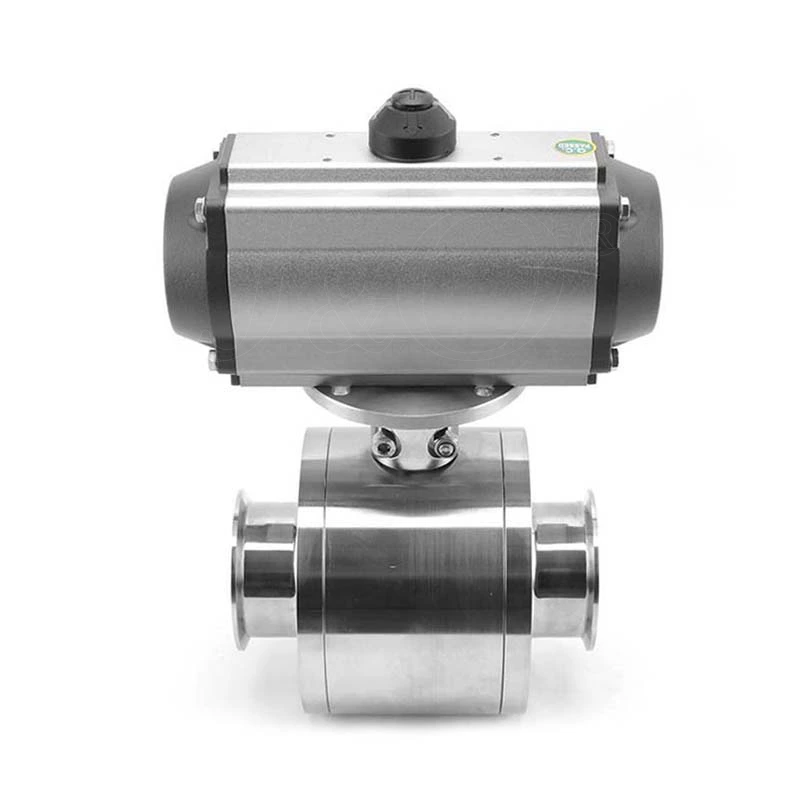The Correct Installation And Maintenance Of The Ball Valve Should Be Like This
The correct installation and maintenance of Sanitary Ball Valve should be like this
1. Confirm the preparation work before the installation of the ball valve
1. Ensure that the pipeline at the installation position of the ball valve is in a coaxial position, and the two flanges on the pipeline should be kept parallel. Confirm that the pipeline can bear the weight of the ball valve itself. If it is found that the pipeline cannot bear the weight of the ball valve, equip the pipeline with corresponding support before installation.
2. Confirm whether there are impurities, welding slag, etc. in the pipeline, and the pipeline must be purged clean.
3. Check the nameplate of the ball valve, and fully open and close the ball valve several times to confirm that the valve can work normally, and then fully check all the details of the valve to ensure that the valve is intact.
4. Remove the protective covers at both ends of the valve, check whether the valve body is clean, and clean the inner cavity of the valve body. Since the sealing surface of the ball valve is spherical, even tiny debris may cause damage to the sealing surface.
2. Installation of ball valve
1. Any section of the ball valve can be installed at the upstream end, and the handle ball valve can be installed at any position of the pipeline. If the ball valve is equipped with an actuator (such as a gear box, an electric-pneumatic actuator), it must be installed vertically, and the valve inlet and outlet are in a horizontal position.
2. Install a sealing gasket between the ball valve flange and the pipeline flange according to the pipeline design requirements.
3. The bolts on the flange need to be tightened symmetrically, one by one, and evenly.
4. If the ball valve adopts pneumatic, electric and other actuators, complete the installation of the gas source and power supply according to the instructions.
3. Inspection after installation of the ball valve
1. After installation, start the ball valve to open and close several times. It should move flexibly, be evenly stressed, and work normally.
2. According to the pipeline pressure design requirements, test the sealing performance of the joint surface between the ball valve and the pipeline flange after pressure is passed.
4. Maintenance of ball valve
1. Only when the pressure before and after the ball valve is removed can the ball valve be disassembled and decomposed.
2. During the disassembly and reassembly process of the ball valve, it is necessary to protect the sealing parts, especially the non-metallic parts, such as O-rings and other parts.
3. When reassembling the ball valve body, the bolts must be tightened symmetrically, step by step and evenly.
4. The cleaning agent should be compatible with the rubber parts, plastic parts, metal parts and working media (such as gas) in the ball valve. When the working medium is gas, gasoline (GB484-89) can be used to clean metal parts. Non-metallic parts are cleaned with pure water or alcohol.
5. The disassembled individual parts can be cleaned by immersion. Metal parts with non-metallic parts that have not been disassembled can be cleaned with a dry rotor pump and a fine and clean silk cloth soaked in cleaning agent (to avoid fiber shedding and adhering to the parts). When cleaning, all grease, dirt, glue accumulation, dust, etc. adhering to the wall must be removed.
6. Non-metallic parts should be removed from the cleaning agent immediately after cleaning and should not be soaked for a long time.
7. After cleaning, wait until the cleaning agent on the washed wall evaporates (you can wipe it with a silk cloth that is not soaked in cleaning agent) before assembling, but do not leave it for a long time, otherwise it will rust and be contaminated by dust.
8. New parts must also be cleaned before assembly.
9. Use grease for lubrication. Grease should be compatible with the metal materials, rubber parts, plastic parts and working media of the ball valve. When the working medium is gas, you can use grease such as Special 221. Apply a thin layer of grease on the surface of the seal installation groove, a thin layer of grease on the rubber seal, and a thin layer of grease on the sealing surface and friction surface of the valve stem.
10. During assembly, metal debris, fiber, grease (except for specified use), dust and other impurities, foreign matter, etc. should not be allowed to contaminate, adhere or stay on the surface of the parts or enter the inner cavity.
